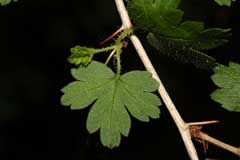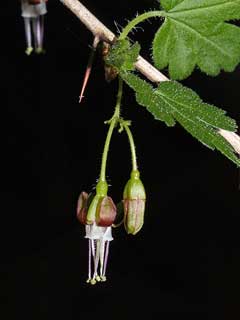 |
|
http://commons.wikimedia.org/wiki/User:Wsiegmund |
 |
| http://commons.wikimedia.org/wiki/User:Wsiegmund |
Translate this page:
Summary
Physical Characteristics

 Ribes divaricatum is a deciduous Shrub growing to 2.7 m (8ft 10in).
Ribes divaricatum is a deciduous Shrub growing to 2.7 m (8ft 10in).
See above for USDA hardiness. It is hardy to UK zone 4 and is not frost tender. It is in flower in April, and the seeds ripen from July to August. The species is hermaphrodite (has both male and female organs) and is pollinated by Insects.
Suitable for: light (sandy), medium (loamy) and heavy (clay) soils and prefers well-drained soil. Suitable pH: mildly acid, neutral and basic (mildly alkaline) soils. It can grow in semi-shade (light woodland) or no shade. It prefers moist soil.
UK Hardiness Map
US Hardiness Map
Synonyms
Grossularia divaricata. Steud.
Plant Habitats
Woodland Garden Sunny Edge; Dappled Shade;
Edible Uses
Edible Parts: Fruit Leaves
Edible Uses:
Fruit - raw or cooked[2, 3, 61, 118, 257]. Sweet and juicy[183]. A very acceptable flavour, though a bit on the acid side[K]. It is considered to be one of the finest wild N. American gooseberries[183]. The fruit is sometimes harvested before it is fully ripe and then cooked[256]. The fruit is about 10mm in diameter[200]. On the wild species the fruit can hang on the plant until the autumn (if the birds leave it alone)[K]. Young leaves and unripe fruits are used to make a sauce[183].
References More on Edible Uses
Medicinal Uses
Plants For A Future can not take any responsibility for any adverse effects from the use of plants. Always seek advice from a professional before using a plant medicinally.
Miscellany TB VD
The inner bark has been chewed, and the juice swallowed, as a treatment for colds and sore throats[257]. A decoction of the bark or the root has been used as an eye wash for sore eyes[257]. An infusion of the roots has been used in the treatment of sore throats, venereal disease and tuberculosis[257]. The burnt stems have been rubbed on neck sores[257].
References More on Medicinal Uses
The Bookshop: Edible Plant Books
Our Latest books on Perennial Plants For Food Forests and Permaculture Gardens in paperback or digital formats.

Edible Tropical Plants
Food Forest Plants for Hotter Conditions: 250+ Plants For Tropical Food Forests & Permaculture Gardens.
More

Edible Temperate Plants
Plants for Your Food Forest: 500 Plants for Temperate Food Forests & Permaculture Gardens.
More

More Books
PFAF have eight books available in paperback and digital formats. Browse the shop for more information.
Shop Now
Other Uses
Miscellany Needles String
The roots have been boiled with cedar (Juniperus spp, Thuja sp.) and wild rose (Rosa spp) roots, then pounded and woven into rope[257]. The sharp thorns have been used as probes for boils, for removing splinters and for tattooing[257].
Special Uses
Food Forest
References More on Other Uses
Cultivation details
Easily grown in a moisture retentive but well-drained loamy soil of at least moderate quality[11, 200]. Requires a very sunny position if it is to do well[11]. Plants are hardy to about -20°c[200]. This species is closely allied to R. rotundifolium[11]. Immune to mildew[101], this species is a parent of many mildew resistant hybrids and is being used in breeding programmes in Europe[200]. Plants can harbour a stage of white pine blister rust, so should not be grown in the vicinity of pine trees[155]. Plants in this genus are notably susceptible to honey fungus[200]. Sometimes cultivated for its edible fruit, there is at least one named variety[183]. In garden design, as well as the above-ground architecture of a plant, root structure considerations help in choosing plants that work together for their optimal soil requirements including nutrients and water. The root pattern is branching: a heart root, dividing from the crown into several primary roots going down and out. The root pattern is suckering with new plants from underground runners away from the plant [2-1].
References Carbon Farming Information and Carbon Sequestration Information
Temperature Converter
Type a value in the Celsius field to convert the value to Fahrenheit:
Fahrenheit:
The PFAF Bookshop
Plants For A Future have a number of books available in paperback and digital form. Book titles include Edible Plants, Edible Perennials, Edible Trees,Edible Shrubs, Woodland Gardening, and Temperate Food Forest Plants. Our new book is Food Forest Plants For Hotter Conditions (Tropical and Sub-Tropical).
Shop Now
Plant Propagation
Seed - best sown as soon as it is ripe in the autumn in a cold frame. Stored seed requires 4 - 5 months cold stratification at between 0 to 9°c and should be sown as early in the year as possible[113, 164]. Under normal storage conditions the seed can remain viable for 17 years or more. Prick out the seedlings into individual pots when they are large enough to handle and grow them on in a cold frame for their first winter, planting them out in late spring of the following year. Cuttings of half-ripe wood, 10 - 15cm with a heel, July/August in a frame[78, 113]. Cuttings of mature wood of the current year's growth, preferably with a heel of the previous year's growth, November to February in a cold frame or sheltered bed outdoors[78, 200].
Other Names
If available other names are mentioned here
North American Worcesterberry,
Native Range
NORTHERN AMERICA: Canada (British Columbia), United States (Oregon (west), Washington (west), California (west))
Weed Potential
Right plant wrong place. We are currently updating this section.
Please note that a plant may be invasive in one area but may not in your area so it's worth checking.
Conservation Status
IUCN Red List of Threatened Plants Status :

Growth: S = slow M = medium F = fast. Soil: L = light (sandy) M = medium H = heavy (clay). pH: A = acid N = neutral B = basic (alkaline). Shade: F = full shade S = semi-shade N = no shade. Moisture: D = dry M = Moist We = wet Wa = water.
Now available:
Food Forest Plants for Mediterranean Conditions
350+ Perennial Plants For Mediterranean and Drier Food Forests and Permaculture Gardens.
[Paperback and eBook]
This is the third in Plants For A Future's series of plant guides for food forests tailored to
specific climate zones. Following volumes on temperate and tropical ecosystems, this book focuses
on species suited to Mediterranean conditions—regions with hot, dry summers and cool, wet winters,
often facing the added challenge of climate change.
Read More
Expert comment
Author
Douglas.
Botanical References
1160200
Links / References
For a list of references used on this page please go here
Readers comment